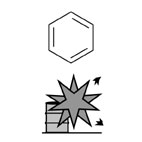| Case Name |
Explosion and fire at a chemical tanker during cargo-handling caused due to static electricity from an insulated level gage |
| Pictograph |

|
| Date |
December 17, 1985 |
| Place |
Kurashiki, Okayama, Japan |
| Location |
Refinery |
| Overview |
On December17th, 1985, a chemical tanker arrived at a jetty in Okayama prefecture to load 1000 tons of benzene. The tanker exploded during loading benzene, and caught fire. A Teflon ring had been inserted between a guide pipe and a float of a level gage of the tanker to prevent noise. This insulated the float against a hull and a charge accumulated. A spark was generated, igniting benzene vapor in the headspace of the hatch, resulting in an explosion and a fire. |
| Incident |
The float of a level gage on a chemical tanker was insulated, generating static electricity during loading/unloading, which caused ignition, and the tanker caught fire. |
| Processing |
Transportation |
| Substance |
Benzene, Fig2 |
| Type of Accident |
Explosion, fire |
| Sequence |
The tanker was at a jetty to load 1000 tons of benzene. The tanker had four hatches. After loading 2nd and 3rd hatches, benzene was being loaded into the 1st hatch. An explosion occurred and the tanker caught fire. The fire spread to a fender of the jetty. Immediately, a shipping operator cut a mooring rope and removed the tanker from the jetty with a tugboat. Then, the fire on the tanker and the pier was extinguished. |
| Cause |
The float of the level gage was equipped with a Teflon ring between a guide pipe and the float to prevent noise. This resulted in insulation between the hull and the float. Charge generated by flowing benzene during loading accumulated at the float. A spark was generated between the pipe and the float, igniting benzene vapor in the headspace of the hatch. |
| Response |
The tanker was moved away from the jetty. Fire extinguishing activities followed. |
| Countermeasures |
1. Prohibition of loading a tanker with an insulated float at a level gage.
2. Inspection of a hatch for projections before arrival at a port.
3. Paying attention to the hazard of an insulated conductor in the hatch.
4. A revision of "Standards of Operation Procedure for Preventing Accidents Caused by Static Electricity" and "Standards for Safety Operation" was made. |
| Knowledge Comment |
Facilities can be unintentionally insulated during operations and after remodeling, even though the facilities were designed or constructed to be grounded. The crews of chemical tankers for dangerous materials do not necessarily have adequate knowledge of hazards and static electricity. The manufacturer of dangerous materials might need to educate crews of chemical tankers. |
| Background |
Insulation of the float of the level gage of the tanker was not considered, which is unusual for a tanker carrying hazardous chemicals. |
| Incidental Discussion |
The climate at Seto Inland Sea in December is extremely dry. The headspace of the hatch must have been filled with a mixture of combustible vapor. A chemical tanker is seldom purged with N2 gas. The oil refinery, which has extensive knowledge of dangerous materials, should also cooperate with crews of chemical tankers to prevent this kind of accident. It takes a long time to reach equilibrium vapor concentration when there is a fluctuating liquid level. When the temperature is high, and when concentration of the gas phase is above the flammable level, fluctuations of a liquid level can result in a concentration in the flammable range, leading to an explosion. In other words, static electricity should never be accumulated regardless of the temperature. |
| Reason for Adding to DB |
Example of explosion and fire caused due to accidental generation of an electrically insulated condition |
| Scenario |
| Primary Scenario
|
Poor Value Perception, Poor Safety Awareness, Inadequate Risk Recognition, Ignorance, Insufficient Knowledge, Convincement, Usage, Operation/Use, Usage of Facility, Malicious Act, Rule Violation, Safety Rule Violation, Bad Event, Electrical Failure, Isolation, Secondary Damage, External Damage, Explosion, Bodily Harm, Death, 4 person died
|
|
| Sources |
High Pressure Gas Safety Inst. of Japan. High-pressure gas accidents. Accidents in 1985. pp.140-141(1986)
High Pressure Gas Safety Inst. of Japan. Chemical tanker. Ignition, explosion, and fire caused by charge integration during cargo-handling. Examples of accidents at petroleum refining and petrochemical units. p.101(1995)
|
| Number of Deaths |
2 |
| Physical Damage |
The bow cracked. A fender of the jetty and a loading rubber hose were destroyed by fire. Benzene was lost. |
| Multimedia Files |
Fig2.Chemical formula
|
| Field |
Chemicals and Plants
|
| Author |
YOSHINAGA, Jun (Graduate School of New Frontier Sciences, The University of Tokyo)
TAMURA, Masamitsu (Center for Risk Management and Safety Sciences, Yokohama National University)
|